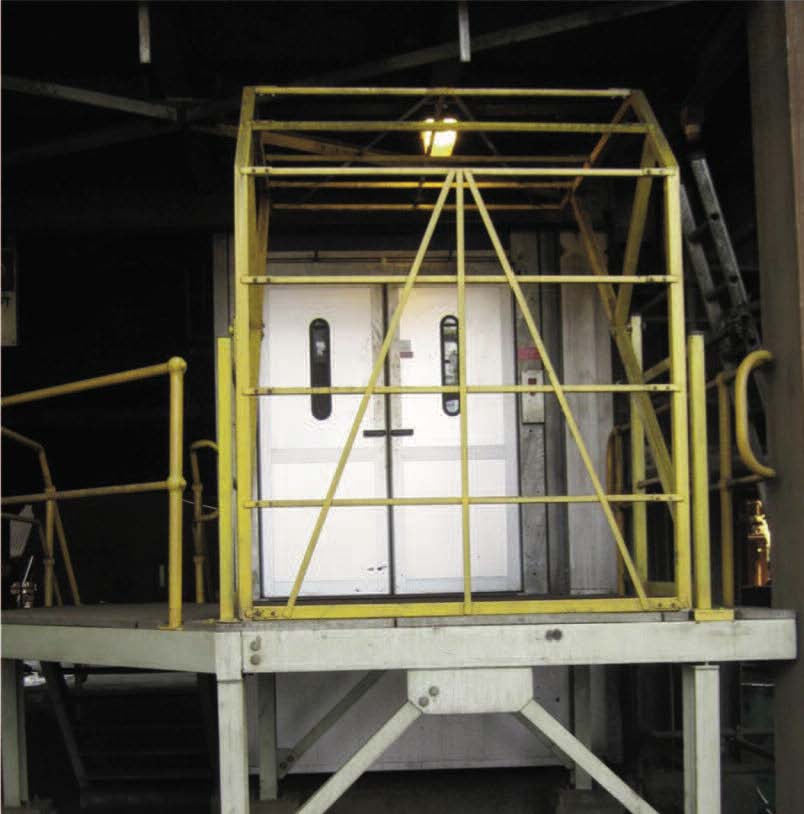Alimak replace a temporary construction hoist with a permanent SE 2000 industrial rack and pinion elevator on the Queensland Nickel Group’s Palmer Nickel and Cobalt Refinery. Installed in 2012, the industrial elevator was engineered to fit a pre-existing shaft within the structure.
Processing the world’s nickel
The Queensland Nickel Group’s (QNI) Palmer Nickel and Cobalt Refinery, located outside of Townsville, QLD, processes an estimated 3.8 million tonnes of nickel laterite and nickelcobalt hydroxide annually. Since its opening in the 1970s, the refinery has become one of the largest nickel processing facilities in the world, manufacturing more than 30,000 tonnes of nickel and 2,000 tonnes of cobalt each year. For over a decade, an Alimak counterweight hoist has provided personnel with access to the Palmer Refinery’s roaster building during busy shut-down periods. In 2012, this temporary hoist was replaced with a permanent Alimak SE 2000 industrial elevator, installed within a pre-existing shaft of the building.
Solving shutdown access issues
Constructed in the early 1970s, the refinery’s 13-floor roaster building is used in the reduction roasting of nickel ore. In the mid 2000’s, a temporary Alimak 28/42 counterweight hoist was installed on the roaster building’s exterior. Servicing nine floors of the structure, the Alimak hoist was used during shutdown periods on the refinery, with two traction elevators providing transportation of personnel throughout the facility.
Engineering an industrial elevator to fit
Working closely to Queensland Nickel’s specifications, Alimak designed, manufactured and installed an SE 2000 rack and pinion elevator to operate within an existing shaft inside the roaster building. A major challenge was ensuring the selected SE 2000 elevator would fit within the pre-designed shaft area; a task that involved careful designing, engineering and several modifications to the shaft. The installation of landing door assemblies proved challenging, with confined space requiring several door assemblies to be installed behind low-hanging beams.
Installation through the rooftop
Given the enclosed space of the shaft, the SE elevator’s installation required the use of a crane to manually lower the mast and elevator car into the shaft from the building’s roof. The structure’s rooftop was re-constructed to enclose the elevator shaft. These weather-proof conditions allowed the elevator-car to be completed with the standard aluminum and galvanized finish, with no additional protective surface treatment required.
Making materials transport easy
While the original Alimak counterweight hoist was fitted to the structure’s exterior and provided access to 9 levels, the new Alimak SE 2000 was installed within an internal elevator shaft and serviced all 13-levels of the roaster building, including the roof. Available for use 24 hours a day, the SE elevator transports materials, equipment and personnel, with a speciallydesigned access platform allowing for the easy loading and offloading of palletized loads. The new Alimak SE 2000 elevator has been in operation at the Palmer Nickel and Cobalt Refinery since June 2012, providing personnel and materials with safe and easy access to the roaster facility’s 13 landings. An ongoing quarterly service contract with Alimak guarantees the elevator is maintained as per the original equipment manufacturer specifications, minimizing machine downtime and extending the life of the elevator.
ELEVATOR DETAILS
Location: Palmer Nickel & Cobalt Refinery, Townsville, QLD, Australia
Industry: Metal and Steel
Application: Nickel refinery, men and material access
Elevator type: Rack and Pinion
Elevator model: Alimak SE 2000
Capacity: 2,000 kg
Elevator car size: 1.56 m x 2.21 m
Speed: 0.6 m/s
No. of landings: 13
Lifting height: 37 m
